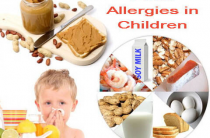Food allergy, being one of the most common types of this disorder, is becoming more and more common every year. Cases of food intolerance often occur in childhood. This is due to the characteristics of the baby's body. At this age, it is often temporary, but in some cases, it can pass into adulthood. In this case, getting rid of it completely is no longer possible.
Causes of food allergies in adults
In adults, the causes of food allergies can be found in the many factors that a person faces daily, as well as in the internal individual processes of the body that underlie this disease.
These include:
- Gastrointestinal Disorders
Diseases of the stomach or intestines, leading to an allergic reaction, are extremely common. The mechanism of development of allergic reactions is based on the interaction of antibodies with certain proteins that the body perceives as hostile. Such proteins can enter the bloodstream with incomplete digestion of food products. Adults who suffer from a food type of allergy should first of all examine the condition of the gastrointestinal tract. An allergy of this nature disappears when the underlying disease is eliminated. Adults often experience allergies to normally tolerated foods, which is often the result of diseases of the digestive system.
- Features of the composition of products
There is a group of foods that are highly allergenic. This is due to the fact that they contain substances that affect the metabolism of histamine (a hormone that triggers allergic reactions). This hormone, in its structure, is a protein, so it can be contained in some products in its original form. These foods include chocolate, hard cheeses, and fish. Also highly allergenic foods include: citrus fruits, strawberries, strawberries, crustaceans and mollusks. Allergic reactions provoked by these products are called “pseudo-allergies”. These reactions are not allergies, because in this case, antibodies that are produced in allergic people do not take part in the development of symptoms.
- Atypical products
We are talking about a variety of fruits, vegetables, cereals or meats that are not typical for representatives of a certain part of the continent. For example, the more northerly a part of the European continent is, the more common citrus allergy is in that area. Citrus fruits, and therefore those unique proteins that are part of these fruits, are not typical for representatives of the northern latitudes. This leads to the fact that the body of a northerner is simply not familiar with such substances and perceives them with hostility. Modern trade and economic globalization leads to the emergence of products that do not correspond to the genetic adaptation of the organism to certain nutritional components. Protecting yourself from allergic consequences, in this case, is not difficult at all. It is enough just to be careful with unfamiliar products and conduct tasting in small portions.
- Modern food industry
The products produced by the modern food industry are far from their original versions. Semi-finished meat products, sweets, canned food contain a huge amount of various substances used to extend the shelf life, enhance taste, give a brighter color, etc. Their introduction into everyday life happened literally 50 years ago. Our immune system was simply not ready for them. Adults use these products with great regularity. Their action has two directions, on the one hand, they cause disruption of the immune system, and on the other hand, they themselves can provoke food allergy symptoms in adults .
- Stress impact
Stress is a serious disruptor to the normal functioning of the immune system when it is greater than the body's ability to adapt to its effects. The impact of emotional stress on the immune system can result in the development of an allergic disease. For various reasons, people often experience the negative impact of stress factors.
- Improper nutrition in childhood
Sometimes, the causes of intolerance in adults to certain foods must be sought in early childhood. They can serve as a lack of breastfeeding or improper introduction of natural products into the diet. Remember that foodstuffs should be given in minimal quantities, taking into account the appropriateness of the introduced product-age.
Food allergy symptoms in adults
Food allergies in adults come with a variety of symptoms. Their diversity is very great. One of the most comprehensive classification systems relates the symptoms of an allergy to the organs it affects. However, it does not allow considering symptoms affecting several organs at once. For this reason, it will be considered separately.
- Nasal mucosa
Contact with a food allergen can be accompanied by a runny nose, as well as prolonged, intense sneezing. The inflammation caused by the allergen causes the nasal capillaries to dilate and the tissues to swell, resulting in severe nasal congestion.
- Eyes
The entry of a food allergen into the general circulation leads to the fact that the mucous membrane of the eye swells, an expansion of the vessel appears. Exposure to an allergen causes intense lacrimation.
- The cardiovascular system
Under the influence of an allergen, the patient may experience an expansion of superficial capillaries.
Exacerbations of allergies can also stimulate an increase in the frequency and strength of heart contractions. Skin symptoms
This symptomatic group is the most common manifestation of food allergy in adults. It may include skin symptoms such as dermatitis, urticaria, swelling of the skin tissue, itching and peeling, as well as the appearance of acne.
- joints
Allergies often provoke inflammation of the joints. As a result, the joints swell, the local and general temperature rises, and joint pain occurs.
- Headache
Migraine symptoms often develop as a result of respiratory failure, provoked by swelling of the nasal passages. Most of the time, a person inhales through the nose, therefore, the lack of oxygen that occurs with swelling of the nasal mucosa provokes migraine attacks.
- Gastrointestinal symptoms
This symptomatology often develops with food allergies in adults. As a result of the influence of allergies, irritations of the mucous membrane are formed, excessive accumulation of gases, provoking bloating and belching, digestion of food is disturbed, pains appear concentrated in the abdomen, stool disorders are possible, expressed as diarrhea and constipation. Symptoms affecting the gastrointestinal tract in adults can cause weakness, decreased performance. This is due to the fact that the development of allergic symptoms disrupts the functioning of the gastrointestinal tract, which absorbs the plastic and energy components of food.
Dermatitis due to food allergies
Allergic dermatitis, as a manifestation of food allergy, can occur in a patient at an early age. In some cases, these symptoms remain in an adult if food intolerance is the result of a persistent violation of the immune system.
In adults, the causes of dermatitis are:
- long-term improper drug therapy;
- excessive excitement and stress caused by overexertion;
- tobacco and alcohol use;
- improper diet and unhealthy diet;
- lack of sufficient night rest;
- hereditary predisposition to allergies.
The main symptom of food allergy dermatitis is the appearance of scaly and itchy areas of an allergic reaction, which over time take the form of red inflammatory spots, on which there are tiny nodules inside which there is liquid. They can burst with an outpouring of contents. In this case, a dense crust forms at the site of their rupture. With dermatitis, the areas where allergic manifestations occur are constantly itchy. This can lead to irritability, sleep disturbance, emotional tension.
Urticaria due to food allergies
In addition to dermatitis, food allergies in adults can take the form of hives. Moreover, skin symptoms are expressed either by dermatitis or urticaria. These symptoms, having different immune response mechanisms, do not intersect within the same disease.
So, what is hives? Urticaria is a symptom of an allergic reaction, which takes the form of pink or red foci of inflammation. Their shape is round, most often irregular. It can be both extensive foci of inflammation, and frequent rashes of a small size. With particularly acute manifestations, urticaria can take on a general character, covering more than 90% of the patient's skin.
Anaphylactic shock
Anaphylactic shock is not a symptom, but a group of symptoms that are caused by an overly acute allergic reaction to a food allergen. Anaphylactic shock, as part of a food allergy, most often develops after eating the following foods: nuts (various types), shrimp and shellfish, whole milk, fish, citrus fruits. We draw your attention to the fact that these foods cause symptoms of anaphylactic shock more often than others. But this does not mean at all that other foods that are an allergen for a particular patient cannot cause such an acute reaction.
And so, anaphylactic shock is a group of symptoms that occurs after exposure to an allergen. First of all, it is a spasm of the laryngeal muscles and bronchi, as well as swelling of the laryngeal tissues, which interrupts the full supply of oxygen with breathing. At the same time, blood pressure drops to critical values, which can cause the heart muscle to stop working.















